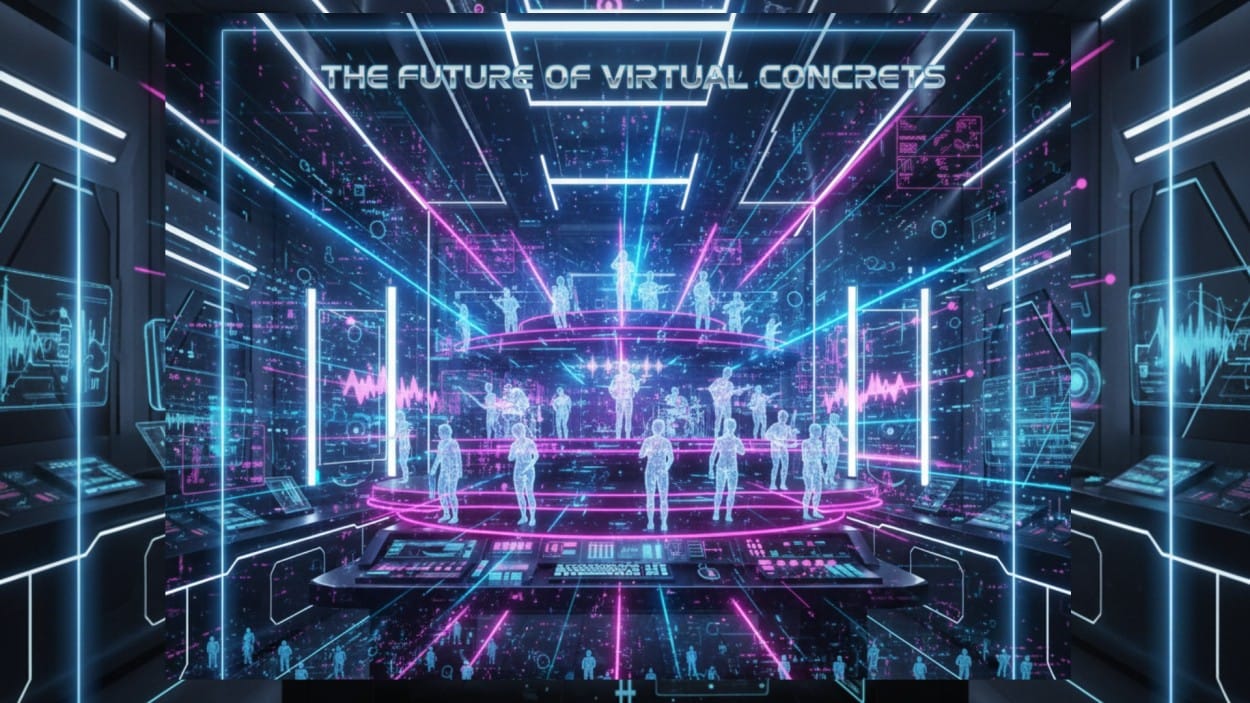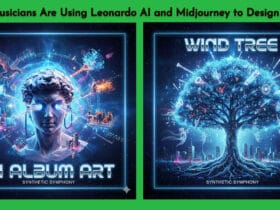Here we go, guys, as we all know, From Studio to Metaverse: The Future of Virtual Concerts is going on. Not long ago, a concert meant tickets, traffic, sweat, and screaming in a crowd.
In 2025, it can also mean this: You’re sitting at home in your pyjamas, wearing a VR headset… And suddenly you’re standing front row at a floating neon stage in the sky, watching your favourite artist perform — surrounded by fans from 100+ countries. Welcome to the era of virtual concerts and the metaverse music revolution.
What Exactly Is a Virtual Concert in 2025?
A virtual concert is more than just a live stream on YouTube or Instagram.
It’s a digitally created performance space — inside platforms like:
- Fortnite
- Roblox
- VRChat
- Meta Horizon Worlds
- custom-built metaverse worlds
where:
- artists appear as avatars or holograms,
- Fans attend as custom avatars,
- and the stage itself can break physics — floating cities, collapsing worlds, underwater arenas, anything.
This isn’t just a concert.
It’s an experience.
How We Got Here: Travis Scott, Marshmello & The First Metaverse Shows
The seeds of metaverse music were planted years ago.
- Marshmello’s Fortnite concert (2019): over 10 million players attended a live in-game show.
- Travis Scott’s “Astronomical” Fortnite event (2020): took things further with a giant digital Travis, planets bending, worlds exploding — pure visual madness.
- Ariana Grande’s Rift Tour, Lil Nas X in Roblox, and virtual K-pop performances continued the trend.
These weren’t “streams inside games.”
They were cinematic experiences built around music.
Now, in 2025, those experiments are turning into a full-blown virtual concert industry. Also, you must know the 20 most popular Music festivals must visit every year.
Why Virtual Concerts 2025 Are Exploding
1. No Geography, No Borders
Fans in India, Brazil, Japan, and Germany can attend the same show at the same time. No visas. No flights. No sold-out venues.
For artists, this means:
- a global fanbase from day one
- more ticket sales
- Multiple time zones show without physical travel
2. Unlimited Creativity
In real life, you’re limited by:
- stage size
- budget
- gravity 😅
In the metaverse, you can:
- perform on a floating island above a black hole
- sing on a stage made of water
- walk through your own lyrics as 3D objects
- turn fans into stars, particles, or glowing spirits
This is where metaverse music beats traditional concerts — visually and emotionally.
3. New Income Streams for Artists
Virtual concerts unlock:
- digital tickets
- exclusive skins & outfits for avatars
- virtual merch (NFT posters, wearable items, emotes)
- VIP access rooms
- fan meet & greets in virtual lounges
Instead of just selling T-shirts and physical passes, artists can sell experiences.
Inside a VR Live Performance: What Fans Actually Feel
A VR live performance in 2025 can look like this:
- You join with a VR headset or PC/phone.
- Your avatar spawns in a huge digital arena.
- The chat is buzzing, emotes flying, digital lights flashing.
- The artist appears — maybe as a giant avatar, an anime character, or a digital clone.
- As the beat drops, the world reacts:
- the sky cracks
- buildings dance
- lyrics float in 3D
- You’re launched into space with the chorus
It’s not just about listening anymore. You feel like you’re inside the song.
Real Artists Already Living in the Metaverse
Beyond Travis Scott and Marshmello, many artists & genres are tapping into metaverse music:
- K-pop groups are hosting virtual showcases with synchronized avatar performances.
- Indie DJs throwing underground sets in VRChat and Decentraland.
- Virtual idols & VTubers doing live animated shows for thousands of fans.
Some artists start as purely digital personas — no public human identity at all.
Their entire career happens from studio to metaverse, never stepping on a physical stage.
Why Metaverse Music Matters for the Future of the Industry
More Access for Fans
Not everyone can afford ₹5,000+ concert tickets, travel, and hotels. Metaverse events can cost a fraction — or even be free with optional purchases.
More Power for Indie Artists
You don’t need a giant label to book a stadium. You can build a virtual venue, sell digital tickets, and perform to thousands from your bedroom.
More Data & Personalization
Artists know:
- Where fans join from
- Which songs get the most emotes?
- What moments spike engagement
This helps them shape better live experiences, both virtual and physical.
From Studio to Metaverse: How a Virtual Concert Is Made
Let’s break down the process:
1. Music Production (Studio Phase)
Artist records songs normally — in a home or pro studio.
2. Visual World Building
3D artists and game designers create:
- the stage
- environment
- visual effects
- avatar designs
3. Avatar & Motion Capture
The artist:
- performs wearing motion capture suits, or
- pre-records movements + facial expressions
This turns their performance into a digital performance.
4. Live Layer
On concert day:
- The performance plays live or semi-live
- Artists often appear as live voice + live control over some elements
- Fans jump, dance, fly, or interact through emotes and mini-events
The result? A hybrid concert that mixes music, gaming, animation, and social interaction.
Will Virtual Concerts Replace Real Ones?
- Short answer: No.
- Long answer: They’ll live side-by-side.
Physical concerts give:
- real crowd energy
- human closeness
- raw performance moments
Virtual concerts give:
- hyper-visual experiences
- global accessibility
- interactive worlds
The future isn’t either/or. It’s both: world tours with real arenas and metaverse shows.
Imagine:
- A physical tour in 15 cities
- A final worldwide VR live performance where everyone can join
That’s where virtual concerts 2025–2030 are heading.
What This Means for Creators & New Artists
If you’re an artist, producer, or creator, metaverse music opens up insane possibilities:
- You can build a virtual brand identity from day one.
- Perform as a character, avatar, or animated persona.
- Host mini-listening sessions in virtual lounges.
- Sell digital collectibles with each song drop.
The studio is no longer the end.
It’s the starting point for a full virtual experience.
The Future of Virtual Concerts: 2026 and Beyond
Here’s what’s coming next:
- AI-powered stages that react to your voice in real time.
- Fans can walk on stage as part of the performance.
- Concerts where fans remix visuals live through votes & interactions.
- Crossovers: anime × gaming × music × virtual fashion in the same event.
- Entire festivals inside the metaverse with multiple stages across different worlds.
Virtual concerts won’t just be the future of music. They’ll be the future of entertainment, social life, and digital identity.
The Conclusion: The Stage Is Everywhere Now
From dusty garages and studios to limitless metaverse stages, the journey of music is evolving faster than ever.
Virtual concerts aren’t a gimmick anymore — they’re a new art form.
- For fans: a chance to be inside the music.
- For artists: a new canvas to paint sound and visuals together.
- For the industry: a new economy of tickets, skins, NFTs, and shared worlds.
The future of live music won’t just be watched. It will be entered, explored, and experienced.











